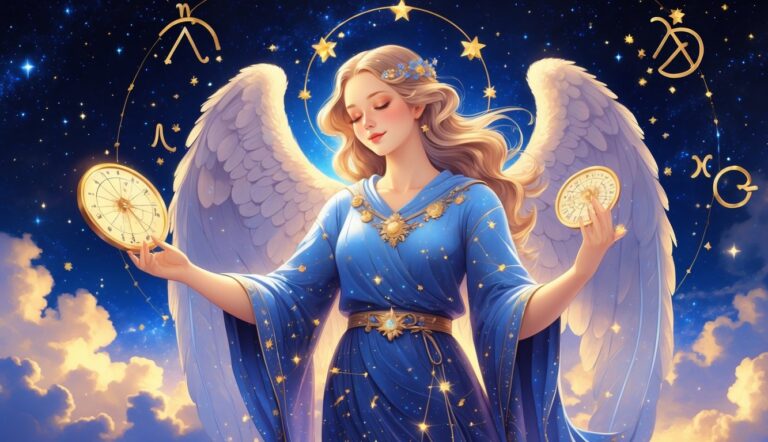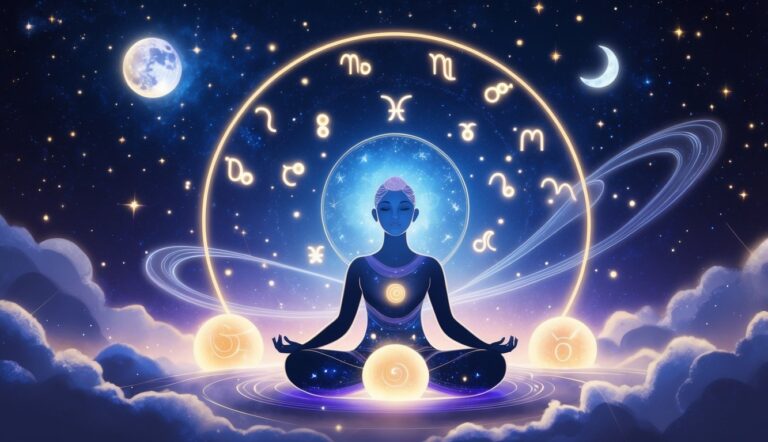Align Your Life with Your True North
The Power Quadrant System decodes your natural talents and pinpoints the career, timing and relationships that let you earn more, love deeper, and wake up eager for the day.
- Uncover your #1 high-income strength
- Draw in partners who raise your energy
- Work when your body’s clock is in “flow”
Goddess spirituality is a vibrant and empowering spiritual path that celebrates the divine feminine.
It’s a way of connecting with the sacred that honors the Earth, nature, and the cycles of life.
You might be drawn to this practice if you’re seeking a more feminine-centered approach to spirituality or if you feel a deep connection to the natural world.
Goddess spirituality focuses on awakening the divine feminine within you and recognizing the interconnectedness of all life. This spiritual path often incorporates elements from ancient goddess worship, modern Neopaganism, and feminist spirituality.
It’s not about replacing one deity with another, but rather embracing a holistic view of the divine that includes both masculine and feminine aspects.
When you explore goddess spirituality, you’ll find a rich tapestry of beliefs and practices.
You might work with specific goddess archetypes, celebrate seasonal rituals, or engage in Earth-based spiritual practices.
Many practitioners find that this path helps them tap into their own inner wisdom, creativity, and power.
It’s a journey of self-discovery and empowerment that can profoundly transform your relationship with yourself and the world around you.
The Origins of Goddess Spirituality
Goddess spirituality traces its roots back thousands of years, emerging from ancient cultures that revered feminine deities.
You’ll find its beginnings intertwined with early agricultural societies and matriarchal systems.
Decode Your Personal Success Blueprint
Power Quadrant System shows you the exact career, relationships, and daily rhythm that match your natural DNA—so you earn more, work happier, and connect deeper.
- Pinpoint your #1 money-making talent
- Erase conflict & attract ideal partners
- Multiply productivity with perfect timing
Historical Context
Goddess worship likely originated in the Neolithic period, around 10,000 BCE.
This era saw a shift from hunter-gatherer societies to agricultural ones.
As people began cultivating crops, they developed a deep connection to the earth’s fertility.
You can see evidence of goddess figures in artifacts from this time.
Small statues depicting voluptuous female forms have been found across Europe and the Middle East.
These figurines often emphasize fertility symbols like large breasts and hips.
The rise of patriarchal systems later pushed goddess worship to the fringes in many cultures.
But it never fully disappeared, persisting in folk traditions and resurfacing in modern times.
Influence of Ancient Civilizations
Ancient civilizations played a crucial role in shaping goddess spirituality.
Tap Into Your Built-In Success GPS
The Power Quadrant System deciphers your genetic blueprint so you can lock onto the career, income and relationships that feel effortless—and wildly rewarding.
- Zero in on your natural high-earning genius
- Sync with partners who boost your vibe
- Wake up driven, finish days fulfilled
In Mesopotamia, you’d find Inanna, the Queen of Heaven.
Egypt revered Isis, while Greece had a pantheon including Athena, Artemis, and Aphrodite.
These goddesses weren’t just fertility symbols.
They embodied wisdom, war, love, and other complex aspects of life.
Their multifaceted nature reflected the diverse roles of women in society.
Celtic and Norse traditions also honored powerful goddesses.
Brigid in Ireland and Freya in Scandinavia were central figures in their respective mythologies.
These northern European goddesses often had ties to nature, healing, and prophecy.
Core Principles of Goddess Spirituality
Goddess spirituality centers on honoring the divine feminine and embracing our connection to the natural world.
It recognizes the sacredness of life’s cycles and the power within each individual.
Reverence for the Feminine Divine
You’ll find that goddess spirituality places the feminine aspect of divinity at its core.
This principle encourages you to seek and honor the goddess in her many forms.
Ancient deities like Isis, Freya, or Kali embody different facets of the divine feminine.
Practices often include creating altars, offering prayers, and invoking goddess energy in rituals.
You might meditate on goddess imagery or use symbols like the spiral or moon to connect with feminine power.
This reverence extends to celebrating the sacred feminine within yourself and others.
It’s about recognizing your own inner goddess and the divine spark in all beings.
Connection to Nature and the Earth
Goddess spirituality deeply values your relationship with the natural world.
You’re encouraged to see the Earth as a living being, often personified as Gaia or Mother Earth.
This connection fosters a sense of respect and responsibility for the planet, emphasizing sustainable living and environmental stewardship. Nature spirituality and Earth’s wisdom guide practitioners to honor the cycles of the seasons, the phases of the moon, and the sacredness of all life.
By attuning to these natural rhythms, individuals cultivate a deeper sense of harmony and interconnectedness with the world around them.
This principle manifests in various ways:
- Spending time outdoors
- Observing seasonal changes
- Participating in Earth-based rituals
You might find yourself drawn to gardening, hiking, or simply sitting quietly in nature.
These activities help you attune to the Earth’s rhythms and energies.
Many followers also adopt eco-friendly practices as a spiritual act.
Caring for the environment becomes a way to honor the goddess in her earthly form.
Cycles of Life and Rebirth
In goddess spirituality, you’re invited to embrace the cyclical nature of existence.
This principle recognizes the constant flow of birth, growth, death, and renewal in all aspects of life.
You’ll often see this reflected in:
- Seasonal celebrations
- Moon phase rituals
- Honoring personal life transitions
The menstrual cycle is viewed as sacred, mirroring nature’s rhythms.
You’re encouraged to track your own cycles and honor the different energies of each phase.
Death is seen not as an end, but as part of a larger cycle.
This perspective can bring comfort and a sense of continuity in facing life’s challenges.
The Goddess in Modern Practices
Goddess spirituality has found vibrant expression in contemporary society through rituals, ceremonies, and everyday practices.
You’ll discover how the divine feminine is honored and integrated into modern life.
Contemporary Rituals and Ceremonies
Goddess rituals often align with lunar cycles and seasons.
You might participate in full moon circles, where women gather to connect with feminine energy.
Seasonal celebrations like Beltane and Samhain honor the Goddess in her various aspects.
Many practitioners create altars at home, adorning them with candles, crystals, and images of goddesses.
These sacred spaces serve as focal points for meditation and offerings.
Guided visualizations help you connect with specific goddesses.
You may be invited to journey inwardly to meet Athena for wisdom or Kali for transformation.
Group ceremonies often involve chanting, dancing, and drumming to raise energy.
You’ll find that these practices foster a sense of community and shared spiritual experience.
Goddess Spirituality in Daily Life
Incorporating the Goddess into your daily routine can be simple yet profound.
You might start your day with a brief meditation, invoking a goddess’s qualities you wish to embody.
Mindful eating becomes a practice of honoring the Earth Goddess.
You can say a blessing before meals, acknowledging the divine feminine’s nourishing aspects.
Self-care rituals take on spiritual significance.
A relaxing bath can become a cleansing ceremony dedicated to water goddesses like Yemaya.
You may find yourself drawn to creative pursuits as expressions of the Goddess.
Art, writing, and music become channels for divine inspiration.
In your relationships, you might cultivate qualities associated with various goddesses – Aphrodite’s love, Artemis’s independence, or Hestia’s nurturing warmth.
Nature walks turn into opportunities for connection with the Goddess in her earthly form.
You’ll likely feel more attuned to the cycles of nature and your own body.
Deities and Archetypes
Goddess spirituality embraces a rich tapestry of divine feminine figures across cultures and time periods.
These deities and archetypes offer powerful symbols for connecting with different aspects of the feminine divine.
Diverse Pantheons and the Feminine Divine
Ancient pantheons feature numerous goddess figures embodying various qualities.
Greek mythology presents Athena, goddess of wisdom and strategic warfare, and Aphrodite, goddess of love and beauty.
Egyptian traditions revere Isis, associated with motherhood and magic.
In Hinduism, you’ll encounter Kali, representing destruction and rebirth, and Lakshmi, goddess of prosperity.
Norse mythology offers Freya, linked to love, beauty, and war.
These diverse goddesses showcase the multifaceted nature of the feminine divine.
Each figure represents different energies and aspects of life, allowing you to connect with specific qualities that resonate with your spiritual journey.
Exploring Different Goddess Figures
When delving into goddess archetypes, you’ll discover recurring themes across cultures.
The Mother archetype, embodying nurturing and creation, appears in figures like Demeter (Greek) and Gaia (Earth Mother).
The Maiden archetype, representing youth and potential, is seen in Persephone (Greek) and Brigid (Celtic).
The Crone archetype, symbolizing wisdom and transformation, manifests in Hecate (Greek) and Cerridwen (Celtic).
Warrior goddesses like Durga (Hindu) and the Morrígan (Celtic) embody strength and protection.
By exploring these archetypes, you can tap into different aspects of the divine feminine, gaining insights and inspiration for your personal growth and spiritual practice.
The Role of Myth and Storytelling
Myths and stories form the foundation of goddess spirituality, conveying ancient wisdom and universal truths.
They connect you to divine feminine energy and provide insights into life’s mysteries.
Creation Myths and Legends
Creation myths in goddess spirituality often feature powerful female deities shaping the world.
You’ll find stories of the Earth Mother birthing all life or the Cosmic Egg hatching the universe.
These tales give you a sense of your place in the grand cosmic order.
Many cultures have goddesses associated with natural cycles.
Think of Demeter and Persephone explaining the seasons, or Amaterasu bringing light to the world.
These myths help you attune to nature’s rhythms.
Legends of warrior goddesses like Athena or Durga show feminine strength.
They inspire you to tap into your own inner power and courage.
Teachings and Moral Lessons
Goddess myths are rich with lessons about life, relationships, and personal growth.
Stories of Inanna’s descent to the underworld teach you about facing your shadows and emerging transformed.
Tales of goddesses like Kuan Yin embody compassion, encouraging you to cultivate kindness.
Myths of Brigid celebrate creativity, inspiring you to nurture your artistic gifts.
You’ll find guidance on navigating love and desire in stories of Aphrodite or Oshun.
Wisdom about cycles of birth, death, and rebirth comes through in myths of triple goddesses like the Morrígan.
These stories offer you a framework for understanding life’s challenges and joys through a feminine spiritual lens.
Goddess Spirituality Movements
Goddess spirituality movements emerged in the late 20th century, bringing female-centered spiritual practices to the forefront.
These movements emphasize reverence for the divine feminine and connection with nature.
Feminist Spirituality
Feminist spirituality arose alongside the women’s liberation movement of the 1960s and 70s.
You’ll find it focuses on reclaiming female power and wisdom through goddess worship and ritual.
Many practitioners draw inspiration from ancient matriarchal cultures and mythologies.
Key aspects include:
- Honoring female deities and archetypes
- Celebrating women’s bodies and cycles
- Creating women-centered sacred spaces
- Exploring intuitive and emotional ways of knowing
Feminist spirituality challenges traditional patriarchal religious structures.
It empowers you to find the divine within yourself rather than looking to external authority figures.
Ecofeminism and the Environment
Ecofeminism links environmental concerns with feminist principles.
You’ll see it views the exploitation of nature as connected to the oppression of women.
This movement encourages you to develop a spiritual relationship with the Earth as a living goddess.
Ecofeminist practices often involve:
- Earth-based rituals and ceremonies
- Activism for environmental causes
- Sustainable living and permaculture
- Herbal medicine and natural healing
By honoring the Earth as sacred, you’re invited to see yourself as part of nature rather than separate from it.
This fosters a sense of responsibility for protecting the environment.
Community and Worship
Goddess spirituality thrives on collective experiences and sacred spaces.
You’ll find a vibrant community centered around shared rituals, gatherings, and personal altars dedicated to the divine feminine.
Groups and Gatherings
You’ll often encounter goddess circles, where like-minded individuals come together to celebrate and honor feminine deities.
These groups may meet on full moons or during significant seasonal transitions.
Rituals vary but often include chanting, meditation, and sharing personal experiences.
You might participate in guided visualizations to connect with goddess energies.
Some communities organize larger festivals, like the increasingly popular Goddess Festivals held in various locations.
These events feature workshops, music, dance, and art celebrations.
Online forums and social media groups have also become popular spaces for you to connect with others interested in goddess spirituality, share resources, and discuss practices.
Sacred Spaces and Altars
Creating a personal altar is a common practice in goddess spirituality.
You can dedicate a small space in your home to honor specific goddesses or the divine feminine in general.
Your altar might include:
- Candles (often in colors associated with specific goddesses)
- Natural objects like stones, shells, or flowers
- Statues or images of goddesses
- Personal mementos or symbolic items
Some practitioners create outdoor altars in nature, aligning with the earth-centered aspects of goddess worship.
Sacred spaces for group worship vary.
You might gather in rented halls, private homes, or natural settings like forests or beaches.
These spaces are often decorated with goddess imagery and natural elements to create a reverent atmosphere.
Challenges and Misconceptions
Goddess spirituality faces several obstacles in gaining widespread acceptance and understanding.
Skepticism from mainstream religions and misinterpretations of its practices can create barriers for practitioners.
Addressing Skepticism and Criticism
You may encounter doubts about the legitimacy of goddess spirituality from those unfamiliar with its principles.
Critics often argue that it lacks historical foundation or theological depth.
To counter this, you can point to archaeological evidence of goddess worship in ancient cultures.
Some view goddess spirituality as a rejection of traditional faiths.
However, you can explain that many practitioners blend elements from various spiritual traditions.
Emphasizing the inclusive nature of goddess spirituality may help alleviate concerns.
You might face accusations of promoting “reverse sexism” by focusing on feminine divinity.
To address this, highlight how goddess spirituality often embraces both masculine and feminine energies in balance.
Clarifying Misunderstandings
A common misconception is that goddess spirituality is solely about worshipping a female deity.
You can clarify that it often involves honoring the divine feminine in nature, oneself, and others.
Some associate goddess spirituality with harmful stereotypes about witchcraft.
To dispel this, explain its focus on personal growth, environmental stewardship, and community support.
You may need to address confusion about practices like rituals or meditation.
Describe these as tools for self-reflection and connection to nature rather than supernatural manipulations.
Emphasize that goddess spirituality is not about rejecting science or reason.
Many practitioners value both spiritual insights and scientific understanding in their worldview.
Integrating Goddess Spirituality
Embracing goddess spirituality can enrich your personal journey and foster connections within diverse communities.
This path offers opportunities for interfaith dialogue and personal growth.
Interfaith Dialogues
You can find common ground between goddess spirituality and other faith traditions.
Many world religions have goddess figures or feminine divine aspects.
Explore these connections to build bridges of understanding.
Look for shared values like reverence for nature, equality, and compassion.
Participate in interfaith events to share your perspectives and learn from others.
You might discover unexpected parallels in rituals or beliefs.
Consider starting a discussion group that welcomes people from various backgrounds.
This can create a safe space for open conversations about spirituality and the divine feminine.
Personal and Communal Growth
Integrating goddess spirituality into your life can spark profound personal transformation.
You might find yourself more attuned to natural cycles and your own inner wisdom.
Try incorporating goddess-centered practices into your daily routine.
This could include meditation, creating altars, or celebrating lunar phases.
As you deepen your connection, you may notice increased self-confidence and empowerment.
Join or form a goddess circle in your community.
These groups offer support, shared rituals, and opportunities for collective healing.
You can learn from others’ experiences and contribute your own insights.
Volunteer for causes aligned with goddess values, like environmental protection or women’s rights.
This practical application of your spirituality can lead to meaningful personal growth and positive social change.
Resources and Further Reading
Looking to explore goddess spirituality further? Here are some valuable resources to deepen your understanding:
Books:
- “Goddess Spirituality for the 21st Century” by Judith Laura
- “The Body of the Goddess” by Rachel Pollack
- “Literary and Cultural Readings of Goddess Spirituality” by Mary Beavis
Websites:
- MotherHouse of the Goddess: Offers a wealth of information and resources on goddess spirituality
Groups and Gatherings:
- Red Tents: Women’s circles focused on honoring the divine feminine
- Goddess circles: Local groups that meet to celebrate and explore goddess spirituality
You might also consider exploring ancient goddess traditions from various cultures, such as Minoan or Indian Mother Goddess worship.
For a comparative perspective, look into works that examine goddess spirituality alongside other philosophical traditions, like tantra.
Goddess spirituality often emphasizes personal experience and connection.
As you explore these resources, trust your intuition and see what resonates with you personally.










